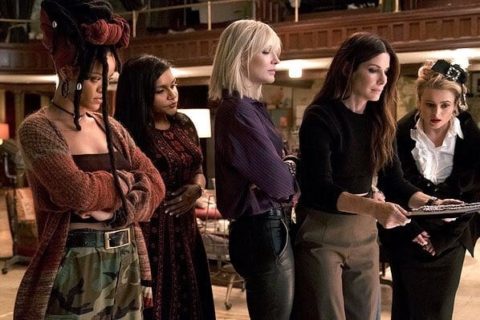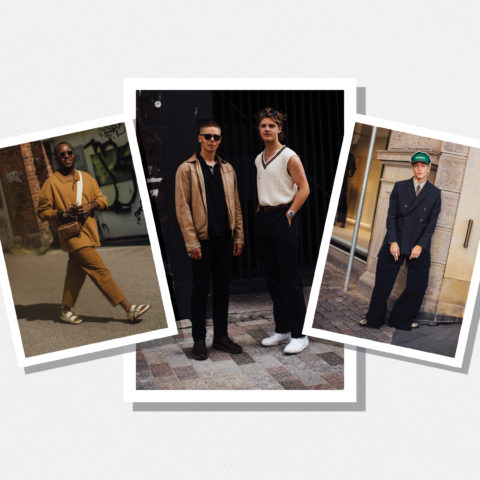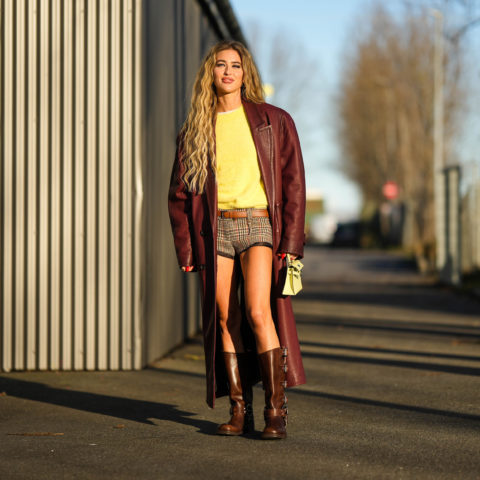The Most Stylish Films of 2018
From period dramas to absurdist comedies
Last year, the fashionable film that people couldn’t stop raving about was Phantom Thread. Makes sense, given that the film is literally about a fashion designer. There are sumptuous silks aplenty, not to mention antique lace, tailored skirt suits and too many elaborate gowns to count. This year, though, the Most Stylish Film mantle could belong to any number of films whose premise has nothing to do with fashion, yet there’s style oozing out of every frame. Here’s our pick of the films whose sharp curatorial eye and strong sense of fashion made them a delight to behold in 2018.
The Favourite
The costume designer for this period film is Sandy Powell, the Oscar winner behind the looks of films like Shakespeare in Love, Carol and Gangs of New York. She’s likely to add another nom to her name with her latest film, The Favourite, which stars Olivia Colman, Rachel Weisz and Emma Stone as the three leads. The 18th century absurdist drama about Queen Anne and the women jostling for power in her court provides the perfect setting for Powell to flex her style muscles, because rather than skewing to historical accuracy, the film’s director Yorgos Lanthimos wanted the film’s costumes to reflect the wicked humour and dark comedy driving the film.
Rather than the over-the-top gowns and pastel frills of the 1700s, Powell decided to embrace a black and white colour palette in order to create a “punk rock” version of the royal court. From repurposed denim for the servants to black laser-cut vinyl and cotton for the court costumes to a dramatic ermine-covered formal robe for the Queen, each look is full of personality.
“Normally I do spend a lot of time on colour. I love colour,” Powell tells Vulture. “But it was quite nice to do something that was different. So because it was black I had to really look into different textures and also things that would light. That sort of worked terribly well within the story and within the settings, and economically actually we had very, very limited funds and time. So there wouldn’t have been time to have done court costumes as they would have been.”
Colette
Over the course of her lifetime, early 20th century French writer Colette lived many lives. Her journey from innocent young girl in the countryside to iconoclastic writer in Paris is a fascinating one, made even more compelling by the fact that she comes into her own as a gender nonconformist during an era when a woman wearing trousers was unthinkable. Costume designer Andrea Flesch used clothes to mirror Colette’s evolution in this biopic about her life starring Keira Knightley.
“What’s special in her character is that she always finds her way to be unique and modern. I feel her wardrobe reflects her independent, sensitive, pure personality, which breaks through the strict rules of fashion at the turn of the century,” Flesch tells Variety.
Flesch poured over archival photographs, paintings and the period fashions of the time to create the costumes, many of which were actually vintage and restored at the Museum of Applied Arts in Hungary.
Black Panther
Costume designer Ruth E Carter has two Oscar nominations to her name—for Amistad and Malcolm X—and has worked on over 40 films, but Black Panther was an experience like none other. The biggest source of inspiration, she tells Forbes, was in “bring[ing] ancient Africa to the foreground in a way that’s never been seen before in cinema.” Featuring an all African and African-American cast, the film depicts a fictional country known as Wakanda, telling the story of its rich history through vibrant colours, traditional crafts and ancient tribal designs.
“I selected things from indigenous tribes and implemented them in a futuristic model,” Ruth E Carter tells British Vogue. “Because the culture that [director] Ryan Coogler created is unique, I could combine elements of many African tribes – including the colour red, the triangle shape, neck rings and beadwork – without worrying about cultural appropriation.”
“The chevron marks on the armour of the all-female warrior clan known as the Dora Milaje, for example, mimic the sacred geometry and imagery found in African artwork,” explains the Vogue piece. “The stacked beadwork suggests the wearer’s marital status, and the tiny talismans on the fighter’s front tabard—a fertility doll, a piece of jade or amethyst perhaps—are symbolic of the wearer’s skill set and spirituality.”
Suspiria
Luca Guadagnino’s follow-up to last year’s runaway hit Call Me By Your Name takes place in a world far, far away from a sun-drenched village in Italy. Suspiria, a remake of Dario Argento’s 1977 cult classic about a dance academy in Germany, is dark and unsettling, its pall of terror amplified by the costumes.
“We made dresses out of real human hair extensions,” the film’s costume designer, Giulia Piersanti, tells Vogue. “They were all draped by hand onto a ribbon cage-like structure to keep the body free for movement and emphasize the bareness of the body, as well. Each piece was different in shape and colour and they were all inspired by Grecian, Madame Grès–esque draping.”
The film’s 1970s setting is evoked through dramatic caftans, printed pussy-bow blouses, midi skirts and patchwork cloaks, inspired by old issues of a West German fashion magazine that Piersanti found on eBay. “Neither Luca nor I wanted colour to be a prominent element in the costumes, but from the very beginning, I knew I wanted to make my own prints for the film,” she tells Dazed. “I was really interested in the works of artists I admire, like Louise Bourgeois and Rebecca Horn, who both use the female body as a tool. I used archetypes of the female body in a series of 70s-style graphic prints, which were then used to make blouses and skirts and dresses.”
If Beale Street Could Talk
Walking out of this film and back into the real world feels like you’ve just put a sepia filter over your eyes. After the deep colours and visual richness of Beale Street, everything else sort of pales in comparison. The colour language of the film is an important element of the story, and one that reflects the original text the film is based on—a James Baldwin novel.
“He gave us the colour. He is so descriptive of colour of the clothing in the book,” costumer designer Caroline Eselin-Schaefer tells The Hollywood Reporter. “Wherever James Baldwin is descriptive of clothing in the book, we wanted to honour it.”
Deep red, blue, yellow and green hues saturate the film, which is set in 1970s New York. Fonny, the male protagonist, wears a red and black checked jacket, while the mother of Tish, the female protagonist, wears a green summer dress, just as described in the novel. But when it came to Tish herself, there wasn’t much to go on. “He’s not really descriptive of Tish,” Eselin-Schaefer says. “We took artistic license with Tish and to show her sort of innocence and purity.”
One of Tish’s standout looks is the cream cape she wears on a date with Fonny. “That cape, to me, was the essence of optimism.… I just think it made her ‘angelic” to signify the hope of their new relationship.” As the story takes a tragic turn, so too does Tish’s style, the optimistic hues of her clothing replaced by darker, more sombre shades.
Crazy Rich Asians
When Cartier is considered “too common” for Singapore’s wealthiest women, you know you’ve got to raise the style stakes way, way high. And it’s precisely what costume designer Mary E Vogt did to depict the OTT lavish lifestyle at the centre of Crazy Rich Asians. They turned instead, to Hong Kong–based bespoke jeweller Carnet, several of whose pieces were featured in the film, alongside dresses from labels like Missoni, Ralph Lauren and Dior.
Director Jon M. Chu advised Vogt to refer to classic fairytales like The Wizard of Oz and Cinderella as a starting point. “And a Wong Kar-wai movie, which is not a fairy tale, that he really loves: In the Mood for Love,” Vogt tells Vulture. “That movie was very influential on this film because of the colours.”
Vogt was also careful to incorporate pieces from local Asian designers, such as Dubai-based Michael Cinco and Kuala Lampur-based Carven Ong.
“Even though the people in Singapore wear a lot of high-end Western clothing, you want to mix in the local culture. That was really really beautiful,” Vogt tells Fashionista.
Ocean’s 8
This film has not one, not two but eight female characters with distinct styles of their own, from Sandra Bullock’s sleek sophisticate to Cate Blanchett’s rock ‘n’ roller to Rihanna’s Rastafarian. Plus, the plot line revolves around the “fashion Oscars” aka fashion’s biggest night aka the Met Gala, so suffice it to say, fashion plays a big role in this film.
“We couldn’t go to Macy’s and buy these dresses, it would never have looked real!,” costume designer Sarah Edwards tells British Vogue. “We had to have access to authentic designer gowns.”
They got access. And then some. Prada! Givenchy! Valentino! Burberry! Even if it wasn’t starring eight of the most sensational women in Hollywood, the film would still be a visual delight.
Sorry to Bother You
This surreal quasi-sci-fi film demanded strong costumes to convey its political, social and cultural themes, and costume designer Deirdra Govan was up to the challenge.
Starring Lakeith Stanfield, Tessa Thompson and Armie Hammer, the satirical comedy tells a complex tale of capitalism, racism and systemic oppression. At one point, Hammer wears an equestrian jacket with a sarong and a riding crop while Stanfield’s outfits range from sober beige and brown sweaters to dapper suits in hues like mauve and green, but the sartorial star of the film is undoubtedly Thompson, who plays a provocative artist named Detroit. Her outfit choices include earrings that read “Kill Kill Kill” and “Murder Murder Murder” and t-shirts spelling out slogans like “The Future is Female Ejaculation.”
“What I loved about the way [Riley] wrote Detroit is that she’s so clear about who she was and what she was doing,” Govan tells The Cut. “I definitely am a product of being here in Brooklyn and part of the afro-chic, Afropunk movement. I wanted to bring a little of that punk funk to Detroit and also let her be experimental, let her paintings speak not only on the walls or in her performance art but also in her clothing.”








